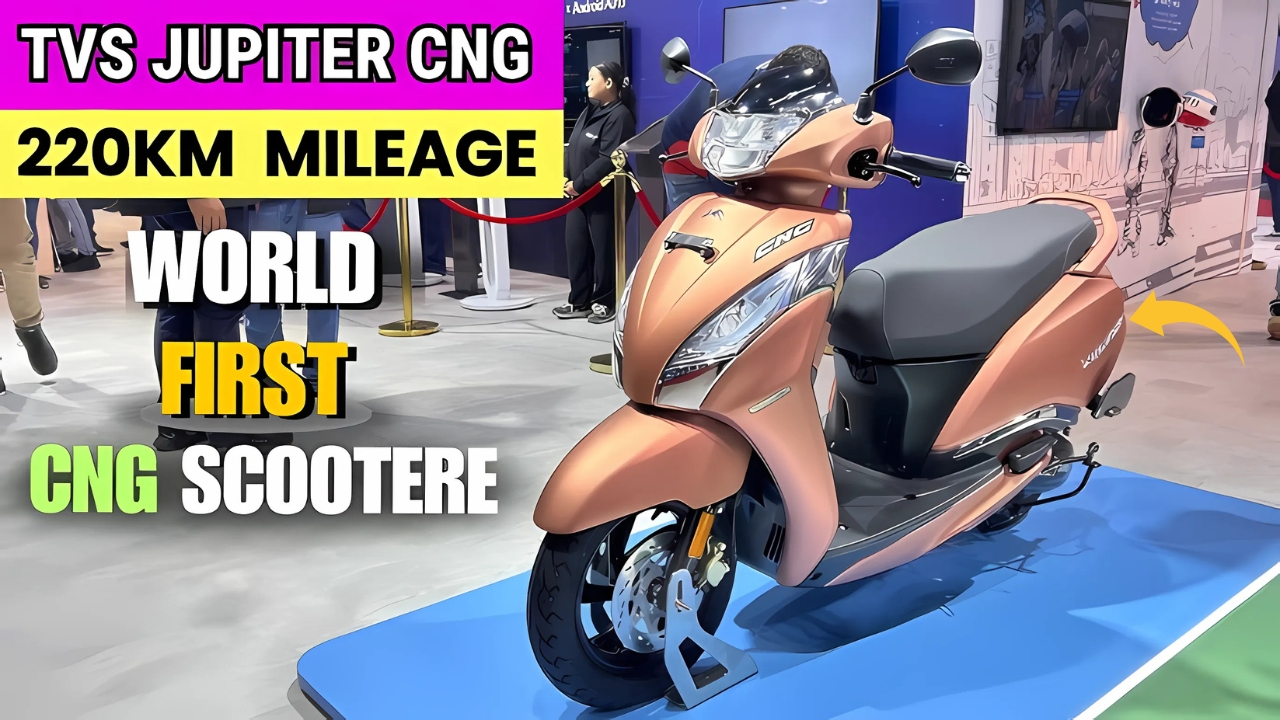TVS Jupiter CNG: The Indian two-wheeler market has witnessed a groundbreaking transformation with the introduction of the TVS Jupiter CNG, marking a significant milestone in sustainable urban transportation.
As environmental concerns intensify and fuel prices continue to fluctuate, TVS Motor Company has pioneered an innovative solution that addresses both economic and ecological challenges faced by daily commuters across India.
The Genesis of CNG Technology in Scooters
The concept of CNG-powered two-wheelers emerged from the pressing need to reduce vehicular emissions while maintaining affordability for the common man. Traditional petrol scooters, though convenient, contribute significantly to urban air pollution and impose substantial fuel costs on users.
The TVS Jupiter CNG represents a paradigm shift, introducing compressed natural gas technology to the scooter segment for the first time in India, making it a trailblazer in the industry.
This revolutionary approach stems from TVS’s commitment to innovation and environmental responsibility. The company recognized that while electric vehicles are gaining momentum, the charging infrastructure in many Indian cities remains inadequate.
CNG, being an established alternative fuel with existing infrastructure, presents a more immediate and practical solution for millions of Indian commuters.
Technical Specifications and Engineering Excellence
The TVS Jupiter CNG operates on a sophisticated dual-fuel system, seamlessly switching between CNG and petrol modes. The scooter features a specially designed 109.7cc single-cylinder engine.
that has been meticulously calibrated to optimize performance across both fuel types. This engineering marvel ensures consistent power delivery while maintaining the reliability that Jupiter users have come to expect.
The CNG kit integration is remarkably seamless, with the compressed gas cylinder strategically positioned beneath the seat without compromising storage space significantly. The system includes advanced safety features such as automatic fuel cut-off mechanisms, pressure regulation systems, and leak detection sensors.
These safety protocols ensure that riders can confidently use CNG technology without any apprehensions about handling compressed gas.
The scooter maintains its signature 12-inch alloy wheels, telescopic front suspension, and robust build quality while accommodating the additional CNG components.
The fuel injection system has been recalibrated to deliver optimal air-fuel mixture ratios for both petrol and CNG operations, ensuring smooth performance transitions between fuel modes.
Economic Advantages and Cost Efficiency
One of the most compelling aspects of the TVS Jupiter CNG is its exceptional cost efficiency. CNG typically costs approximately 60-70% less than petrol, translating to substantial savings for daily commuters.
For an average user traveling 50-60 kilometers daily, the fuel cost savings can amount to thousands of rupees monthly, making the initial investment in CNG technology highly economical.
The dual-fuel capability provides users with flexibility and peace of mind. When CNG runs out, the automatic system switches to petrol mode, ensuring uninterrupted mobility. This eliminates range anxiety commonly associated with alternative fuel vehicles, as users always have petrol as a backup option.
Maintenance costs for CNG vehicles are generally lower due to cleaner combustion, which reduces engine wear and extends component life.
The reduced carbon deposits and cleaner burning characteristics of CNG contribute to longer service intervals and decreased maintenance requirements, further enhancing the economic benefits.
Environmental Impact and Sustainability
The environmental benefits of the TVS Jupiter CNG are substantial and multifaceted. CNG burns significantly cleaner than petrol, producing approximately 20-30% fewer carbon dioxide emissions and virtually eliminating particulate matter emissions.
This reduction in harmful pollutants directly contributes to improved air quality in urban areas where two-wheelers constitute a major portion of vehicular traffic.
The combustion of CNG produces minimal nitrogen oxides and hydrocarbons compared to conventional petrol engines. This cleaner burning characteristic helps reduce the formation of ground-level ozone and smog, contributing to healthier urban environments.
For cities struggling with air pollution challenges, widespread adoption of CNG two-wheelers could significantly improve air quality indices.
Furthermore, CNG is predominantly methane, a naturally occurring gas that can be sourced domestically, reducing dependence on imported crude oil. This energy security aspect makes CNG adoption strategically beneficial for the country’s overall energy independence goals.
Performance and Riding Experience
Despite running on an alternative fuel, the TVS Jupiter CNG delivers impressive performance metrics. The scooter maintains its characteristic smooth acceleration and comfortable riding dynamics across both fuel modes.
The power output remains adequate for urban commuting, with the CNG mode providing sufficient torque for navigating city traffic and moderate inclines.
The transition between CNG and petrol modes is virtually imperceptible to the rider, thanks to sophisticated fuel management systems.
The scooter’s digital instrument cluster provides real-time information about fuel levels in both tanks, enabling riders to monitor consumption patterns and plan refueling accordingly.
Comfort features remain unchanged, with the Jupiter CNG retaining its spacious seating, practical storage solutions, and user-friendly ergonomics. The additional weight from the CNG system is well-distributed, ensuring that handling characteristics remain predictable and confidence-inspiring.
Infrastructure and Accessibility
The success of CNG vehicles depends heavily on refueling infrastructure availability. Fortunately, India has been expanding its CNG network consistently, with major cities already having well-established CNG stations.
The government’s continued support for CNG infrastructure development ensures that accessibility will improve further, making CNG two-wheelers increasingly viable across more regions.
Current CNG networks in metropolitan areas like Delhi, Mumbai, and Pune provide adequate coverage for daily commuting needs. The expanding network in tier-2 cities indicates growing opportunities for CNG vehicle adoption beyond major urban centers.
Market Reception and Future Prospects
The TVS Jupiter CNG has received encouraging market response, particularly from cost-conscious consumers and environmentally aware buyers.
Fleet operators, delivery services, and daily commuters have shown significant interest due to the compelling economic advantages and environmental benefits.
The success of this pioneering model has encouraged other manufacturers to explore CNG technology for two-wheelers, indicating a potential market shift toward alternative fuel adoption in the segment. This competitive interest will likely drive further innovations and improvements in CNG two-wheeler technology.
Conclusion
The TVS Jupiter CNG represents more than just a product launch; it symbolizes the Indian automotive industry’s commitment to sustainable mobility solutions.
By successfully integrating CNG technology into a popular scooter platform, TVS has demonstrated that environmental responsibility and economic viability can coexist harmoniously.
As urban centers grapple with pollution challenges and consumers seek cost-effective transportation solutions, the Jupiter CNG offers a practical pathway toward cleaner mobility.
The scooter’s success could catalyze broader adoption of alternative fuel technologies in the two-wheeler segment, contributing to India’s overall environmental and energy security objectives.
The TVS Jupiter CNG stands as a testament to Indian engineering ingenuity and environmental consciousness, paving the way for a cleaner, more sustainable future in personal mobility.
Its introduction marks the beginning of a new era where alternative fuel two-wheelers become mainstream options rather than niche products, ultimately benefiting both consumers and the environment.










